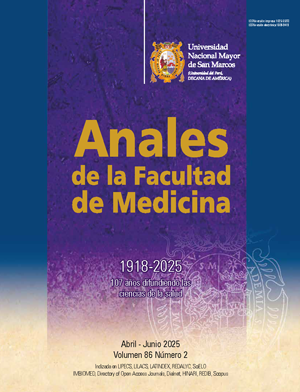Factors influencing the number of physiotherapy sessions in post-traffic accident rehabilitation patients at a Lima medical center, Peru
DOI:
https://doi.org/10.15381/anales.v86i2.30087Keywords:
Physical Therapy Services, Rehabilitation, Traffic Accidents, Peru, Insurance AccidentAbstract
Introduction. Traffic accidents are one of the leading causes of physical disability in Peru. Physical therapy plays a key role in restoring functionality, and its duration varies depending on several factors. Identifying these factors could improve therapeutic planning and patient follow-up. Objectives. To determine the number of physical therapy sessions and associated factors in patients undergoing post-traffic accident rehabilitation covered by the Mandatory Traffic Accident Insurance (SOAT). Methods. We conducted a cross-sectional study using records of patients treated in 2022 at a specialized physical medicine and rehabilitation center in Lima, Peru. We included individuals aged ≥18 years covered by SOAT. A quasi-Poisson regression model was used to estimate the number of physical therapy sessions. Results. We analyzed 683 medical records. Of the patients, 67.1% were male, and the median age was 32 years (IQR: 27–41). The lower limb was the most frequently affected region (44.2%), and fractures were the most common type of injury (42.6%). The median number of sessions was 19 (IQR: 10–30); among patients who completed treatment, it was 20. Patients from other regions received 38% fewer sessions than those from Metropolitan Lima (95%CI: 0.39–0.93; p=0.031). Those who underwent post-accident surgery received 30% more sessions (95%CI: 1.16–1.45; p <0.001). Conclusions. Among patients receiving SOAT-covered physical therapy, the median number of sessions was 19, and 20 among those who completed treatment. Surgery and medical re-evaluation were associated with a higher number of sessions, while living outside Lima was associated with fewer sessions.
Downloads
Published
Issue
Section
License
Copyright (c) 2025 Sergio Padilla Gonzales, Viviana L. Cornejo Luyo, Daniel A. Ramírez Lupuche, Franco Romaní-Romaní, Tomás Nakazato Nakamine

This work is licensed under a Creative Commons Attribution-NonCommercial-ShareAlike 4.0 International License.
Those authors who have publications with this magazine accept the following terms:
- Authors will retain their copyrights and guarantee the journal the right of first publication of their work, which will be simultaneously subject to Creative Commons Attribution License that allows third parties to share the work as long as its author and its first publication this magazine are indicated.
- Authors may adopt other non-exclusive licensing agreements for the distribution of the version of the published work (eg, deposit it in an institutional electronic file or publish it in a monographic volume) provided that the initial publication in this magazine is indicated.
- Authors are allowed and recommended to disseminate their work over the Internet (eg: in institutional telematic archives or on their website) before and during the submission process, which It can produce interesting exchanges and increase quotes from the published work. (See El efecto del acceso abierto ).



